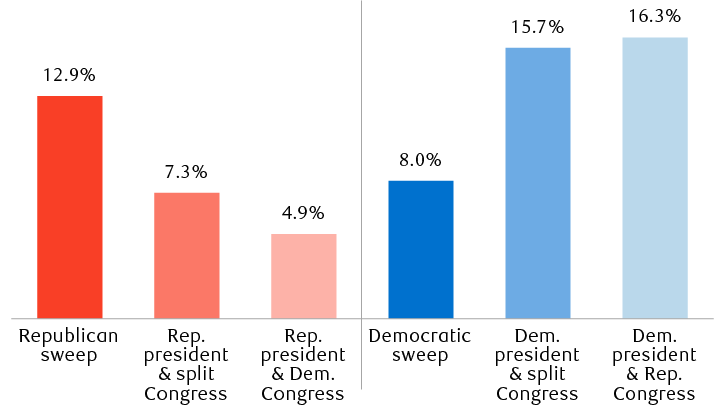The S&P 500 rallied to another new all-time high and other major U.S. indexes jumped as well following news that Donald Trump was once again elected president of the U.S. and Senate control flipped to the Republicans. Trump is only the second person in American history elected to two non-consecutive presidential terms, the other being Democratic President Grover Cleveland in the late 19th century.
The fact that there was a clear winner just hours after West Coast polls closed was a relief to equity market participants.
While vote counting is ongoing in some House of Representatives races as of this writing, it’s looking to us like Republicans will retain control of the lower chamber of Congress by a slim margin, which would usher in a Republican sweep. Decision Desk HQ, a firm leveraged by The Hill, a news agency that covers Congress closely, estimates that Republicans have an 85 percent likelihood of retaining House control based on the results of very competitive races and vote counting in others as of midday Thursday.
The U.S. stock market has historically performed well during a Republican sweep configuration, rising 12.9 percent on average, as the chart shows.
Average annual S&P 500 returns since 1953 by party control

Column chart showing historical S&P 500 annual returns under various party control scenarios of the federal government. The S&P 500 rose 12.9%, on average, during periods of a Republican sweep (when the party controlled the presidency and both chambers of Congress). It rose 7.3% when the Republicans controlled the presidency and control of the Congress was split between Republicans and Democrats. It also rose 4.9% when Republicans controlled the presidency and the Democrats controlled both chambers of Congress. It rose 8.0% during periods of a Democratic sweep. It rose 15.7% when Democrats controlled the presidency and control of Congress was split between Republicans and Democrats. It rose 16.3% when Democrats controlled the presidency and Republicans controlled both chambers of Congress.
Source - RBC Wealth Management, Bloomberg; data through 12/31/23; data based on price returns (does not include dividends)
The market’s focus on the pro-growth agenda
From our vantage point, market participants seem optimistic about three important factors:
Tax rates on individuals have the potential to stay low and some provisions could be lowered further. If Republicans win control of the House, we think Congress would pass and Trump would sign a new tax package to extend much or all of the low-tax provisions which became law during his first term. This would impact individual income tax rates, and taxes on estates, gifts, capital gains, and dividend income, among other provisions. Trump’s additional campaign proposals for “no tax on tips” and to eliminate taxes on Social Security retirement benefits could be added to any new tax legislation that would extend the existing low-rate provisions. (For more about Trump’s tax proposals and the tax legislation process, see and pages 2–5 of this report.)
Tax rates on corporations will likely remain at the low 21 percent rate, at most, and some domestic manufacturers could see their tax rates cut to 15 percent. Also, other business-friendly tax incentives could be written into the tax code if the Republican sweep plays out.
Trump’s goal of aggressive deregulation is being embraced—for now. On this score, we think the market’s enthusiasm may be getting ahead of itself. As they say in the great state of Missouri, “show me.”
Trump aimed to deregulate during his first term and achieved this in certain areas, particularly the energy sector. Also, the number of new regulations during Trump’s presidency was initially lower than the first three years of the Biden, Obama, and Clinton administrations, and was even slightly below the George W. Bush administration. But in the fourth year of Trump’s term, the number of regulations surged, perhaps partly due to the pandemic. In total, his administration ended up implementing more economically significant new regulations than Obama did in his first term (see chart on page 9 of this report).
While Trump genuinely seeks to cut red tape and drastically reduce regulations in his second term—as do his key advisors and many Republicans in the House and Senate—we think there will be obstacles:
- Federal agency rulemaking can be laborious and tedious, and “deregulation” often requires new regulations;
- Career federal agency employees, who have historically been more aligned with the Democratic Party, could slow the process or put a spoke in the wheel;
- Lawsuits will likely challenge certain deregulation provisions and could come from various and well-funded interest groups, including those tied to the Democratic Party and progressive organizations;
- Federal court rulings could stall or halt specific deregulatory efforts; and
- We think the Supreme Court’s so-called Chevron ruling tilts authority back to the judicial branch, specifically regarding the interpretation of ambiguous legislation.
Tariff worries are lurking
So far, the U.S. equity market seems to be looking past the economic risks associated with Trump’s tariff proposals.
Perhaps market participants are waiting to gauge whether the actual implementation of tariffs could be as aggressive as his original campaign proposals for 10 percent across-the-board tariffs on all goods imports, including from allied countries, and 60 percent tariffs on Chinese imports.
We tend to view tariffs and other trade barriers as mostly lose-lose propositions. RBC Global Asset Management Inc.’s Chief Economist Eric Lascelles has pointed out that while tariffs undeniably hurt the country that has tariffs levied against it, they usually also hurt the country levying them.
Even so, Lascelles forecasts that the drag on economic growth and the impact on inflation could be manageable for the U.S. economy in both the “original tariffs” and “partial tariffs” scenarios.
In the original tariffs scenario (10 percent on all goods and 60 percent on Chinese goods), he estimates that after two years of implementation, U.S. GDP would be 1.5 percent smaller than it otherwise would have been, and inflation would be 0.8 percent higher than it otherwise would have been.
In the partial tariffs scenario, he estimates U.S. GDP would be 0.2 percent smaller, and inflation would be 0.2 percent higher after two years of implementation.
Economic implications of potential tariffs
Deviation in GDP and consumer inflation from normal trend after two years from the implementation of Trump’s original 10% global and 60% Chinese tariffs proposals
| Country | Real GDP | Consumer price inflation | ||
|---|---|---|---|---|
| Original tariffs | Partial tariffs | Original tariffs | Partial tariffs | |
| U.S. | -1.5% | -0.2% | 0.8% | 0.2% |
| China | -1.6% | -0.3% | 0.0% | -0.1% |
| Canada | -2.5% | -0.3% | 0.8% | -0.1% |
| Mexico | -2.3% | -0.3% | -0.4% | -0.1% |
| Eurozone | -1.0% | -0.2% | -0.4% | 0.0% |
| UK | -0.7% | -0.1% | -0.4% | 0.0% |
| Japan | -0.7% | -0.1% | -0.6% | -0.1% |
| India | -0.3% | 0.0% | -0.9% | -0.2% |
| South Korea | -1.6% | -0.2% | -0.7% | -0.2% |
| World | -1.1% | -0.2% | -0.3% | -0.1% |
Source - RBC Global Asset Management Inc. Chief Economist Eric Lascelles; data as of 8/5/24
In this video, Lascelles further discusses why he doesn’t think the worst-case tariff scenarios will play out and how the other pro-growth measures that Trump is proposing could offset the GDP headwinds from tariffs. However, tariffs could impact Fed policy due to their inflationary impulses, which Lascelles also addresses in the video.
At a minimum, we think tariff policy has the potential to generate volatility for the U.S. and other equity markets in the months ahead.
How to factor industry beneficiaries into portfolio allocations
On the first day after the election, four S&P 500 sectors outperformed—Financials, Industrials, Consumer Discretionary, and Energy. Small-capitalization stocks also rallied strongly. We think this has become the consensus “Trump presidency/Republican sweep trade” for the time being.
For long-term investors, is it worth making big adjustments in portfolios to tilt more toward these areas of the market?
While these areas may have further near-term outperformance, we think it’s important to keep in mind that over the course of a full four-year presidential term, things don’t always pan out according to the president’s policy preferences.
Just because a president tends to favor (or disfavor) certain industries doesn’t mean market performance will follow suit. One example: The Energy sector performed well soon after Trump was elected in 2016 and had other spurts of outperformance during his presidency. But in the latter part of 2018 the sector began to struggle, and during his full four-year term it badly underperformed the S&P 500 for a variety of reasons. There are other examples associated with the Biden administration.
Regarding Industrials, RBC Capital Markets LLC’s Head of U.S. Equity Strategy Lori Calvasina points out that she currently views this sector as being expensive from a valuation standpoint and it underperformed when Trump imposed tariffs on China in 2018.
Regarding small-cap stocks, Calvasina thinks they look “a bit stretched” at this stage, and notes that moves associated with the last two elections were short-lived. We think the direction of interest rates, inflation, and Fed policy will be much greater determinants of small-cap performance in the coming months and years.
The bottom line is that other factors tend to dictate stock performance more than who sits in the Oval Office and which political party controls Congress. Industry and sector tilts in portfolios should be evaluated according to a range of factors, not solely political ones.
Furthermore, well-balanced equity portfolios should already have exposure to these areas of the market.
Elections come and go: Don’t deviate from long-term investment plans
There is little doubt in our minds that market participants will pay more attention to Washington than they have under Biden, as we expect Trump’s policies to be accompanied by dramatic rhetoric and his actions to be bolder. This could generate some equity market volatility at times.
For long-term investors, we think the most prudent strategy vis-à-vis elections is to:
- Give deference to the long-term investment strategy that you already have in place; and
- Avoid the temptation of making drastic asset class or sector changes based on the election outcome.
If you’re enthusiastic about Trump retaking the White House, don’t get out over your skis.
If you’re concerned about another Trump presidency, don’t let emotions get in the way of sound investment decisions. Markets have risen under both Republican and Democratic presidents.
Ultimately, over the course of the next four years, we think the U.S. equity market will be impacted more by the natural ebb and flow of the business cycle, Fed policy, and innovation. Washington can influence the business cycle for good or for bad, but it doesn’t control it.
For more post-election analysis, watch this video by RBC Global Asset Management Chief Economist Eric Lascelles.

